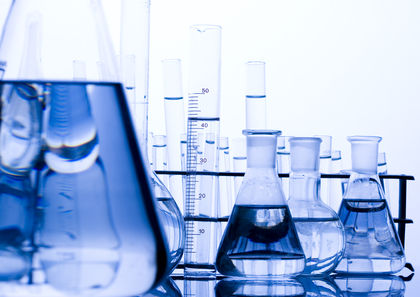Acids and bases

Acids and bases are chemical compounds that have distinctive properties in water solution. The sour taste of a lemon, lime, or grapefruit, for example, is caused by citric acid. The slippery feel of ammonia, a common base, is characteristic of all bases. One of the most interesting properties of acids and bases is the way they react with indicators. An indicator is a material that changes color in the presence of an acid or a base. For instance, the hydrangea flower can be either pink or blue, depending on the amount of acid or base present in the soil in which it is planted.
Acids and bases have been known since prehistoric times. Vinegar, for example, is a water solution of acetic acid that has been used for centuries. The first modern definitions for acids and bases were suggested by Swedish chemist Svante Arrhenius (1859–1927). Arrhenius proposed that acids be defined as chemicals that produce positively charged hydrogen ions, H + , in water. By comparison, he suggested that bases are compounds that produce negatively charged hydroxide ions, OH − , in water. Acids and bases react with each other in a reaction called neutralization. In a neutralization reaction, the hydrogen ion from an acid and the hydroxide ion from a base react to form a molecule of water:
H + + OH − → H 2 O
Other definitions of acids and bases
Since the time of Arrhenius, chemists have adopted other ways of defining acids and bases. In 1923, English chemist Thomas Lowry (1874–1936) and Danish chemists J. N. Brønsted (1879–1947) and N. Bjerrum (1879–1958) suggested defining acids as chemicals that donate a proton (specifically H + ) in a chemical reaction and bases as chemicals that accept a proton. This definition is slightly more comprehensive than Arrhenius's definition and, in many cases, more useful to chemists.
Another definition of acids and bases was suggested in 1923 by American chemist Gilbert Newton Lewis (1875–1946). According to Lewis, an acid could be thought of as any compound that accepts a pair of electrons from another substance; bases, on the other hand, could be thought of as compounds that donate a pair of electrons.
Most acids and bases fit all three of these definitions, but some are covered by only one or both of the more modern definitions.
Strong and weak acids and bases
One of the most important characteristics of acids and bases is their strength. The strength of an acid or base depends on the number of hydrogen ions or hydroxide ions produced in water solution. For example, suppose that 100 molecules of an acid are added to water. Of those 100 molecules, imagine that 99 release hydrogen ions. That acid is said to be a strong acid. In comparison, suppose that 100 molecules of a second acid release only 10 hydrogen ions in water. That acid is said to be a weak acid.
Examples of strong acids are hydrochloric acid (HCl), sulfuric acid (H 2 SO 4 ), and nitric acid (HNO 3 ). Among the best-known strong bases are sodium hydroxide (NaOH), potassium hydroxide (KOH), and calcium hydroxide (CaOH 2 ). The weak acids include acetic acid (HC 2 H 3 O 2 ), lactic acid (CH 3 CHOHCOOH), and oxalic acid (H 2 C 2 O 4 ). The most familiar weak base is ammonia (NH 3 ).
Neutralization
Acids and bases are sometimes described as the chemical opposites of each other. If equivalent quantities of an acid and a base are combined, the two compounds react to form a salt and water. For example:
HCl + NaOH → NaCl + H 2 O
hydrochloric acid + sodium hydroxide → sodium chloride + water
This process is known as neutralization.
Neutralization has many practical applications. For example, agricultural land is often too acidic or too basic to grow certain crops. Farmers can add either a weak acid or a weak base to produce the level of acidity or basicity in which various plants grow best. Reclamation (restoration) of land once used for mining also involves neutralization reactions. Such land is often too acidic for plants to grow. Treating the land with calcium oxide neutralizes acids remaining in the soil and restores its fertility.
Neutralization is also used to deal with environmental problems. Gases produced in factories, power generating plants, and other industrial facilities are usually acidic. When they escape into the air, they react with water to form acid rain. Scrubbers that contain bases can be attached to the inside of smokestacks in such plants to neutralize acids in escaping gases. Treatment with acids or bases is also used to neutralize hazardous chemicals produced by a variety of manufacturing operations.
Uses of acids and bases
Acids and bases can be found everywhere in the world around us. Lactic acid occurs in sour milk, citric acid in citrus fruits, oxalic acid in rhubarb, malic acid in apples, and tartaric acid in wine. Baking soda, antacids, and lye all contain bases.
Acids and bases are also used widely in industry. Three of the top ten chemicals produced in the United States each year are acids or bases. In 1994, 40 billion kilograms (or about 90 billion pounds) of sulfuric acid were manufactured in the United States, making it the number one chemical in the chemical industry. In addition, 12 billion kilograms (about 26 billion pounds) of sodium hydroxide and 11 billion kilograms (about 25 billion pounds) of phosphoric acid were produced.
The most important single use of acids and bases is in the manufacture of other chemicals. Fertilizers, synthetic fabrics, pigments, petroleum, iron and steel, explosives, dyes, plastics, pesticides, soaps and detergents, paper, film, and many other chemicals are produced from acids and bases. They are also used for various other purposes, including cleaning surfaces, refining oil and sugar, electroplating metals, and treating food products.
good luck!
What are the beneficial and harmful effects of the characteristics of acids and bases??